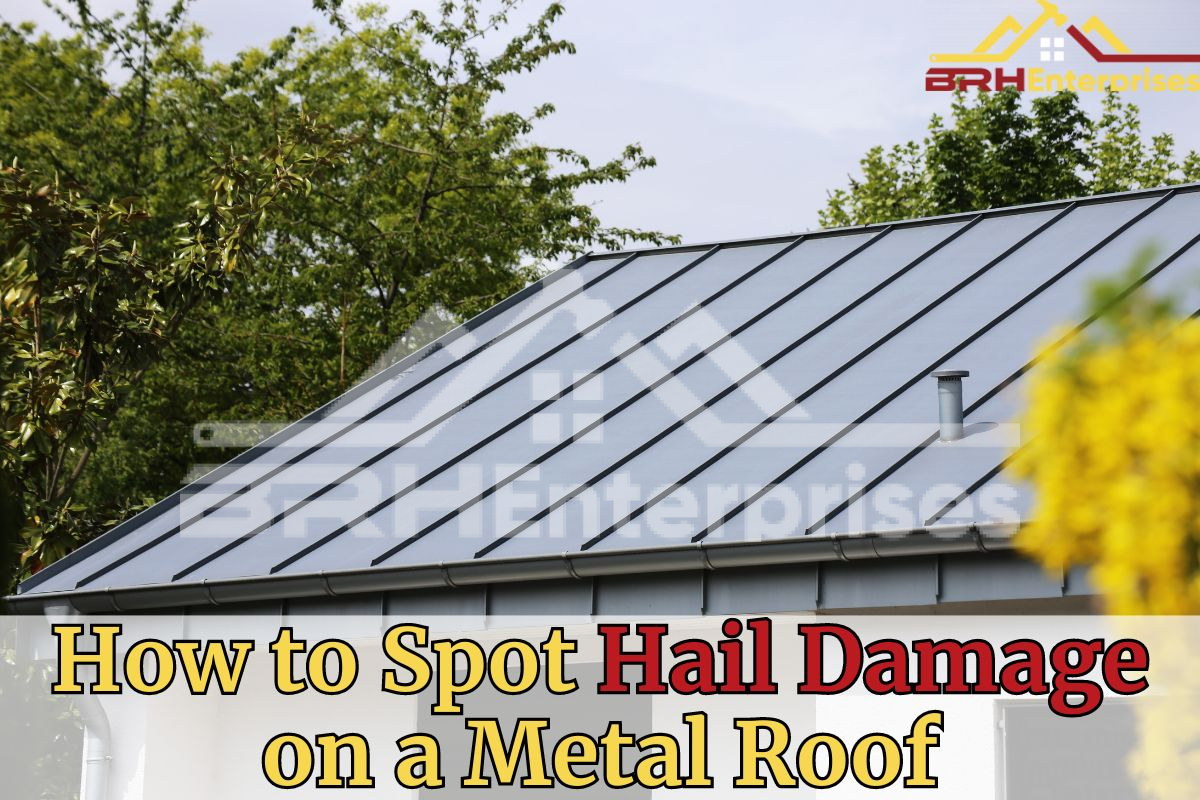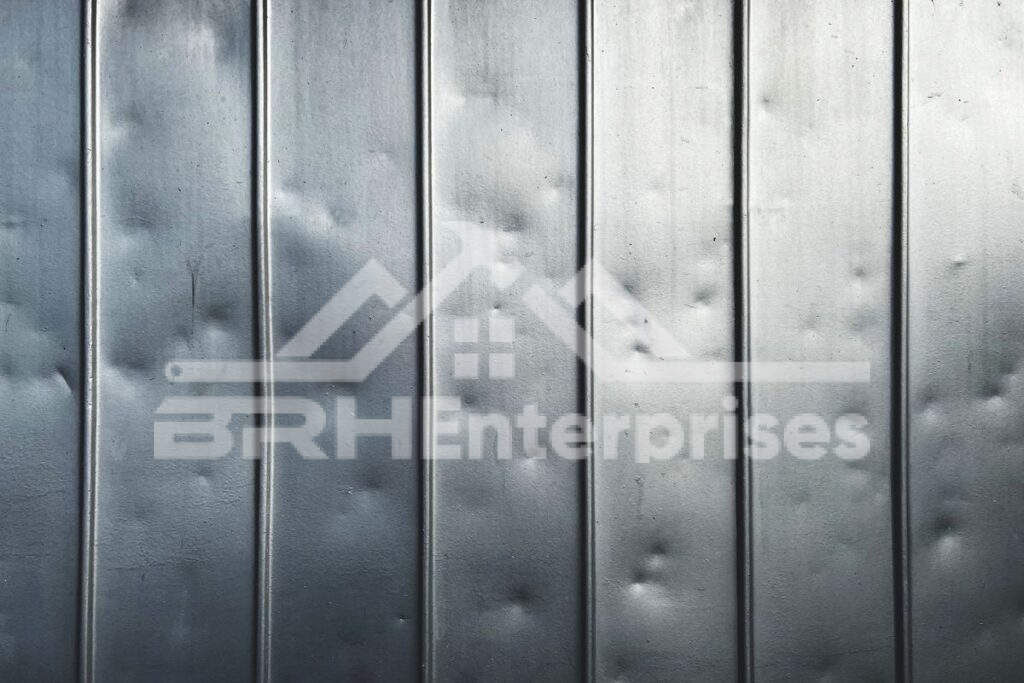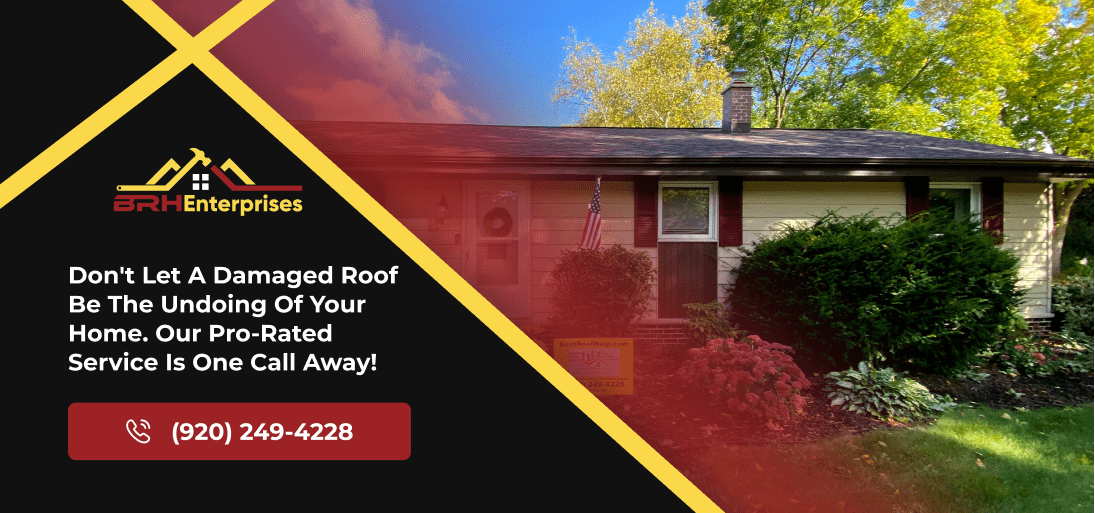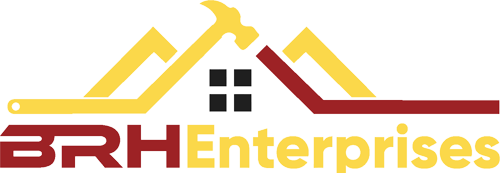How to Spot Hail Damage on a Metal Roof
Estimated Reading Time : 6 Min.

Metal roofs are well known for their durability and longevity, but even these strong structures can be damaged by extreme weather events like hailstorms. Failure to detect and treat hail damage promptly can result in costly consequences such as leaks, structural issues, and even premature roof failure.
Let’s delve into this blog post to learn how to identify metal roof hail damage.
What Kind Of Effect Does Hail Damage Have On Metal Roofs?
Hail can impact metal roofs in a variety of ways. The force of hailstones can dent, chip, or peel protective coatings, exposing the underlying metal and increasing the risk of corrosion. Hail may also loosen or damage fasteners, leaving exposed areas prone to water infiltration and rust.
Furthermore, hail can crack or peel a metal roof’s paint or finish, reducing its aesthetic appeal and speeding up deterioration. Although metal roofs are generally resistant to hail damage, severe impacts can cause leaks, corrosion, and major structural issues if not addressed quickly.
Different Ways To Spot Hail Damage on a Metal Roof
Hail damage to a metal roof can be difficult to detect, especially if it is minor or scattered. Recognizing the signs of hail damage is critical to ensuring your roof’s integrity and longevity.
Here are some key points that can help you identify hail damage on a metal roof:
#1. Dents and Dings

Dents, dings, indentations, and scratches are common signs of hail damage on a metal roof, causing uneven areas. Hailstones can leave small dents and dings, especially on panels and ridges, ranging in size from a pea to a golf ball.
Identifying Dents and Dings
Examine the roof for unusual marks, small rounded dents, depressions, and metal deformation or warping. To identify hail damage, inspect the entire roof surface, including panels, ridges, and valleys, as these issues can cause rust and corrosion over time.
#2. Loose or Missing Fasteners

Hail can expose fasteners on metal roofs, indicating more extensive damage and potentially jeopardizing structural integrity. Hailstorms frequently loosen or dislodge the fasteners that secure metal roofing panels. Inspecting the roof’s edges and seams for loose or missing fasteners is critical. Prompt attention to loose or missing fasteners can help to prevent additional damage and keep the roof secure.
Identifying Loose or Missing Fasteners
Check for loose, wobbly, or not secured fasteners and any that are missing or have fallen out. Inspect for damage, such as bent or broken screws or bolts, as well as deformed or failed fasteners. Finding and fixing these issues as soon as possible is critical for preventing water from seeping in and causing damage.
#3. Cracked or Chipped Paint
Hailstones can chip or crack the paint finish on metal roofing panels, exposing the metal beneath to the elements. If left untreated, exposed metal can rust and corrode, causing your roof to deteriorate even further.
Inspecting for Cracked or Chipped Paint
When inspecting a metal roof for hail damage, start by looking for scratches, chips, or flaking paint that exposes the underlying metal. For a closer look, gently remove any loose paint with a paint scraper. If you find any scratches or chips, use a paint touch-up kit to repair the damage and keep it from deteriorating further.
#4. Rust Or Corrosion
One common indicator of hail damage is corrosion or rust. Hailstones can chip or strip protective coatings, leaving the metal vulnerable to the elements. This exposure accelerates corrosion, potentially weakening the roof’s structure. Moisture, humidity, and other environmental factors can also contribute to this issue. If neglected, corrosion can cause substantial damage, compromising the metal roof’s effectiveness.
Identifying Rust Or Corrosion
To spot rust or corrosion on a metal roof, look for rust spots, chipped or flaking paint, or exposed fasteners. Be attentive to areas lacking protective coating and signs of water damage, indicating vulnerability. Seeking a professional inspection is crucial for a thorough assessment and repair recommendations for suspected corrosion.
#5. Bent or Warped Panels
Large hailstones can bend or warp metal roof panels, which is especially concerning when they are near the roof edges. This can have an impact on the roof’s structural integrity and potentially lead to leaks. The forceful impact of hailstones can cause misshapen panels, allowing water ingress and resulting in interior water damage to walls, ceilings, and floors. Any bent or warped panels must be addressed immediately to avoid further deterioration and potential collapse.
Identifying Warped Panels
Do a visual inspection of the roof from the ground or with a ladder. Check for signs of bending or warping, such as misshapen panels, gaps, or ripples. Examine panels for deviations from their original shape and rust or corrosion, especially near the edges.
#6. Damaged HVAC Units
Intense hail fall presents a serious risk to HVAC units, frequently causing extensive damage such as dents, punctures, and broken components. Given the critical role of HVAC systems in maintaining indoor comfort and health, these types of damage are especially concerning.
Furthermore, damage to seals and gaskets can result in leaks and water damage, jeopardizing the system’s integrity. Hail can damage the electrical components of HVAC units, causing malfunctions or even electrical fires, highlighting the critical need for hailstorm protection measures.
Inspecting for A Damaged HVAC Unit
Look for dents and cracks on the exterior, especially around vents and grills. Check for signs of water damage like rust or stains, indicating leaks or seal damage. Test airflow and watch for disruptions, which could signal external or internal damage. Lastly, inspect for electrical issues such as flickering lights or unusual odors, suggesting damage to electrical components.
#7. Damage To Other Roof Components
Chimney covers, vents, gutter guards, and satellite dishes are all susceptible to damage during hailstorms. Dents and chips on chimney covers, especially near the edges, can allow water to seep underneath, causing further damage.
Similarly, dented vents and gutter guards may indicate broader roof damage and affect airflow and water drainage. Satellite dishes can suffer dents and chips that compromise functionality, particularly if near the edges.
Identifying The Damage
Look for signs like dents, scratches, or chips on roofing components. Rubbing chalk over the chimney cover can reveal hidden damage. Ensure proper functionality, particularly for airflow in vents and water through gutter guards, and signal reception for the satellite dish.
Will Insurance Pay For Hail Damage To Metal Roof?
In Wisconsin, metal roof insurance policies typically include coverage for hail damage, though the extent of coverage varies. Some policies only cover structural damage, while others cover both structural and cosmetic damage. When hail damages your metal roof, it’s essential to review your policy to figure out the extent of your coverage.
If you have a cosmetic damage waiver, minor dents or scratches may not be covered. However, if the damage reduces the lifespan of your roof or causes functional issues, you should be able to file a claim. To accurately assess the damage and ensure appropriate compensation, consult with both your insurance company and a reputable contractor.
What Size Hail Will Damage A Metal Roof?
| Hailstone Size | Damage Caused |
| 1 inch | Noticeable dents, shallow but may compromise roof integrity |
| 1.25 inches | Deeper dents, potential punctures, leaks, and water damage |
| 1.5 inches | Significant damage, punctures, dents, extensive leaks, and water damage |
| 1.75 inches | Severe damage, large dents, punctures, significant water damage, potential roof collapse |
Can You Fix Hail Damage On Your Metal Roof Yourself, Or Is It Better To Hire A Roofing Professional?
While it is possible to repair hail damage on a metal roof on your own, it is generally recommended that you hire professional roofing services for several reasons. Safety is one of the biggest concerns because navigating a metal roof can be dangerous without the proper training and equipment.
Qualified roofing professionals have specialized knowledge of metal roofing systems and can accurately assess and repair hail damage to avoid future problems. They can also help with insurance claims and provide warranties for their services, giving homeowners long-term protection and peace of mind.
Conclusion
Spotting hail damage on a metal roof is essential for preventing problems and maintaining your home’s value. By understanding the signs of damage mentioned above, you can protect your home and ensure the longevity of your roof.
Don’t hesitate to contact professionals for assistance and always prioritize safety. Protect your home against hail damage with BRH Enterprises! Our expert hail damage roofing solutions provide your roof with long-lasting materials and protective coatings. Contact BRH Enterprises at (920) 249-4228 and put your home in good hands.


